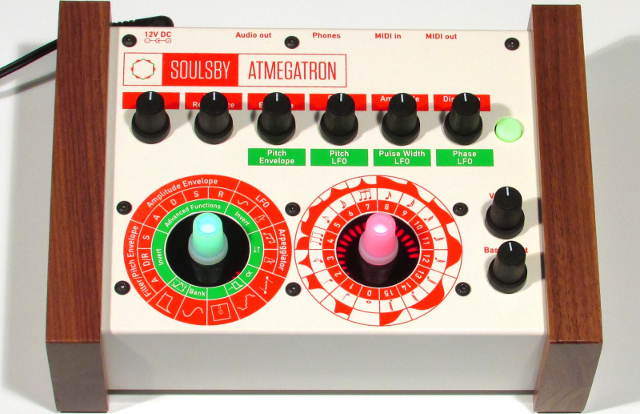The Atmegatron is the first product of Paul Soulsby that create a small and relative simple and fairly cheap monophonic digital synthesizer. You either can buy the PCB kit and build yourself or get the fully build synthesizer. The unique thing is that users also can get the Arduino development platform themselves and start altering the firmware.

As for now there already is alternative sound engine firmware available that creates the synth into a 8-bit 8kHz drum machine and they are working on a 4-voice paraphonic version as well. If you can find your way around C you even can start to write your own firmware if you want to.
The synthesizer itself is a small box with wooden side panels. Eight pots, one lighted push button and two rotary encoders on top. The back has midi in and out, 3,5mm headset, mono 1/4″ output, USB connector and a power supply input for a power adapter. As to the headset output that should have been a normal headset output. The USB connector pins that connect to a USB cable that can be connected in a wrong and right way should have been a mini-USB socket. Having a cable with loose wires will cause durability issues especially for live gigging. The build quality is fairly decent. The pots and rotary dials feel pretty sturdy.
The pots and rotary dials make editing this synths very intuitive and low-level. The six main pots are basically data entry points that have a dual function in combination with the button on the side. And next to the volume pot you also have a pot for adding a bit more low end to the output. The two rotary dials are one selection dial and a data entry dial with a led ring around them. Both also can be pushed like a push button and change color. Using red and green colors may be a challenge for the colorblind though.
The internal synth engine consists of various wave shapes, pulse width modulation, envelopes, LFO and wave shapers. In addition there is portamento mode and a midi sync able arpeggiator. The sound of the synthesizer is unmistakably sounding like an 8-bit synthesizer and its fairly easy to get the chip tune sounds. So it goes well beyond the basses and leads and ventures quite far in FX territory. Especially with the bit crusher in high gear it will unleash the 8-bit dirt.
For people with an experimental mindset the Atmegatron can be very interesting in the studio and also for live venues. For people who want to design their own softsynths this platform can be a interesting first step to get into the technical side and start using the Arduino development platform. To that regard it makes sense the sales cause the first batch to be sold out. Hopefully the upcoming batches will feature a MkII with improvements on the backside connections.
Wouter Veltmaat
